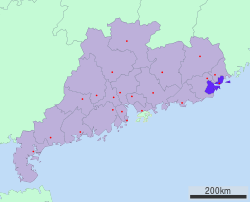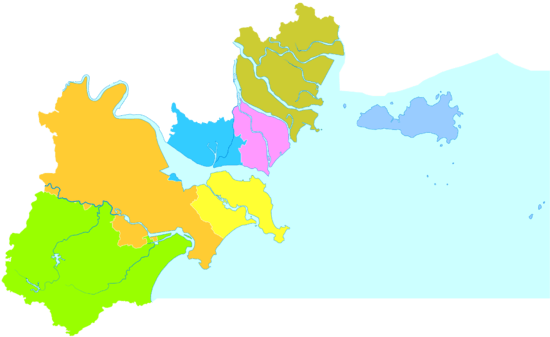Shantou
Shantou, formerly romanized as Swatow[1] and sometimes known as Santow from its local Teochew pronunciation, is a prefecture-level city on the eastern coast of Guangdong province, China, with a total population of 5,391,028 as of 2010 and an administrative area of 2,064 square kilometres (797 sq mi). Shantou has direct jurisdiction over six districts and one county, and the six urban districts of Shantou have a population of 5,330,764. With it and the surrounding cities of Jieyang and Chaozhou, the metropolitan region known as Chaoshan covers an area of 10,404 km2 (4,017 sq mi), and had a permanent population of 13,937,897 at the end of 2010. It's built up area spread of 11 districts was home to 11,635,577 inhabitants at the 2010 census.[2]
Shantou, a city significant in 19th-century Chinese history as one of the treaty ports established for Western trade and contact, was one of the original Special Economic Zones of the People's Republic of China established in the 1980s, but did not blossom in the manner that cities such as Shenzhen, Xiamen and Zhuhai did. However, it remains eastern Guangdong's economic centre, and is home to Shantou University, a member of the Project 211 group.
History
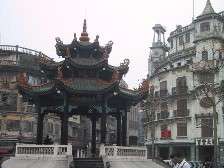
Shantou was a fishing village part of Tuojiang Du (鮀江都), Jieyang County (揭陽縣) during the Song Dynasty. It came to be Xialing (廈嶺) during the Yuan Dynasty. In 1563, Shantou was a part of Chenghai County (澄海縣) in Chao Prefecture (Chaozhou). As early as 1574, Shantou had been called Sha Shan Ping (沙汕坪). In the seventeenth century, a cannon platform called Shashantou Cannon (沙汕頭炮臺) was made here, and the placename later was shortened to "Shantou". Locally it has been referred to as Kialat.
Connecting to Shantou across the Queshi Bridge is Queshi (礐石) which had been known by the local people through the 19th century as Kakchio. It was the main site for the American and British Consulates. Today the area is a scenic park but some of the structures are somewhat preserved from its earlier history. In 1860, Shantou was opened for foreigners and became a trading port according to Treaty of Tientsin.[3]
It became a city in 1919, and was separated from Chenghai in 1921. 1922 saw the devastating Swatow Typhoon, which killed 5,000 out of the 65,000 people then inhabiting the city.[4] Some nearby villages were totally destroyed.[5] Several ships near the coast were totally wrecked.[6] Other ones were blown as far as two miles inland.[5] The area around the city had around another 50,000 casualties.[6] The total death toll was above 60,000,[7] and may have been higher than 100,000.[6]
In the 1930s, as a transport hub and a merchandise distribution centre in Southeast China, Shantou Port's cargo throughput ranked third in the country. A brief account of a visit to the city in English during this period is the English accountant Max Relton's A Man in the East: A Journey through French Indo-China (Michael Joseph Ltd., London, 1939). On June 21, 1939, Japanese troops invaded Shantou.[8] Japanese force occupied Shantou until 1945.[9]
With higher-level administrative authority, Shantou governed Chaozhou City and Jieyang City from 1983 to 1989.[10]
Geography
| Shantou | ||||||||||||||||||||||||||||||||||||||||||||||||||||||||||||
|---|---|---|---|---|---|---|---|---|---|---|---|---|---|---|---|---|---|---|---|---|---|---|---|---|---|---|---|---|---|---|---|---|---|---|---|---|---|---|---|---|---|---|---|---|---|---|---|---|---|---|---|---|---|---|---|---|---|---|---|---|
| Climate chart (explanation) | ||||||||||||||||||||||||||||||||||||||||||||||||||||||||||||
| ||||||||||||||||||||||||||||||||||||||||||||||||||||||||||||
| ||||||||||||||||||||||||||||||||||||||||||||||||||||||||||||
Shantou is located in eastern Guangdong with latitude spanning 23°02′33″ – 23°38′50″ N and longitude 116°14′40″ – 117°19′35″ E; the Tropic of Cancer passes through the northern part of the city, and along it there is a monument, in fact the easternmost in mainland China, at 23°26′33″N 116°35′20″E / 23.44240°N 116.58885°E.[12] The highest peak in the city's administration is Mount Dajian (大尖山) on Nan'ao Island, at 587 m (1,926 ft); the highest peak on the geographic mainland is Mount Lianhua (莲花山), at 562 m (1,844 ft) in Chenghai District. The city is located at the mouths of the Han, Rong (榕江), and Lian Rivers.
Shantou is 187 miles (301 km) north of Hong Kong.[13]
Climate
Shantou has a monsoon-influenced humid subtropical climate (Köppen Cfa), with short, mild to warm winters, and long, hot, humid summers. Winter begins sunny and dry but becomes progressively wetter and cloudier. Spring is generally overcast, while summer brings the heaviest rains of the year though is much sunnier; there are 8.2 days annually with 50 mm (1.97 in) of rainfall. Autumn is sunny and dry. The monthly 24-hour average temperature ranges from 13.8 °C (56.8 °F) in January to 28.3 °C (82.9 °F) in July, and the annual mean is 21.53 °C (70.8 °F). The annual rainfall is around 1,630 mm (64 in), about 60% of which occurs from May to August. With monthly percent possible sunshine ranging from 28% in March to 58% in July and October, the city receives 1,979 hours of bright sunshine annually.
| Climate data for Shantou (1971–2000) | |||||||||||||
|---|---|---|---|---|---|---|---|---|---|---|---|---|---|
| Month | Jan | Feb | Mar | Apr | May | Jun | Jul | Aug | Sep | Oct | Nov | Dec | Year |
| Average high °C (°F) | 17.9 (64.2) |
17.9 (64.2) |
20.3 (68.5) |
24.3 (75.7) |
27.4 (81.3) |
29.9 (85.8) |
31.8 (89.2) |
31.5 (88.7) |
30.2 (86.4) |
27.7 (81.9) |
23.9 (75) |
19.9 (67.8) |
25.2 (77.4) |
| Average low °C (°F) | 10.7 (51.3) |
11.5 (52.7) |
14.1 (57.4) |
18.2 (64.8) |
21.8 (71.2) |
24.5 (76.1) |
25.6 (78.1) |
25.5 (77.9) |
24.0 (75.2) |
20.5 (68.9) |
16.0 (60.8) |
12.0 (53.6) |
18.7 (65.7) |
| Average rainfall mm (inches) | 33.6 (1.323) |
66.8 (2.63) |
99.5 (3.917) |
172.9 (6.807) |
213.5 (8.406) |
286.9 (11.295) |
227.2 (8.945) |
258.5 (10.177) |
140.8 (5.543) |
52.3 (2.059) |
41.3 (1.626) |
38.1 (1.5) |
1,631.4 (64.228) |
| Average rainy days (≥ 0.1 mm) | 7.2 | 10.8 | 12.7 | 13.3 | 15.3 | 17.1 | 13.4 | 13.7 | 9.9 | 5.2 | 4.8 | 5.2 | 128.6 |
| Average relative humidity (%) | 78 | 80 | 82 | 82 | 85 | 86 | 83 | 83 | 81 | 77 | 76 | 75 | 80.7 |
| Mean monthly sunshine hours | 143.2 | 96.0 | 101.7 | 112.8 | 134.7 | 170.9 | 239.7 | 218.6 | 200.7 | 207.6 | 181.2 | 171.5 | 1,978.6 |
| Percent possible sunshine | 43 | 30 | 28 | 30 | 33 | 42 | 58 | 55 | 55 | 58 | 55 | 52 | 44.9 |
| Source: China Meteorological Administration [11] | |||||||||||||
Administration
Shantou is a prefecture-level city. It has direct jurisdiction over six districts and one county.
| Administrative divisions of Shantou | ||||||||||||
|---|---|---|---|---|---|---|---|---|---|---|---|---|
| Division code[14] | English name | Chinese | Pinyin | Area in km2[15] | Population 2010[16] | Seat | Postal code | Divisions[17] | ||||
| Subdistricts | Towns | Residential communities | Administrative villages | |||||||||
| 440500 | Shantou City | 汕头市 | Shàntóu Shì | 2248.39 | 5,389,328 | Chancheng District | 515000 | 37 | 32 | 517 | 548 | |
| 440507 | Longhu District | 龙湖区 | Lónghú Qū | 119.42 | 536,356 | Jinxia Subdistrict | 515000 | 5 | 2 | 80 | 32 | |
| 440511 | Jinping District | 金平区 | Jīnpíng Qū | 146.15 | 810,284 | Shipaotai Subdistrict | 515000 | 17 | 169 | |||
| 440512 | Haojiang District | 濠江区 | Háojiāng Qū | 179.89 | 267,463 | Dahao Subdistrict | 515000 | 7 | 60 | |||
| 440513 | Chaoyang District | 潮阳区 | Cháoyáng Qū | 664.91 | 1,626,357 | Wenguang Subdistrict | 515100 | 4 | 9 | 93 | 179 | |
| 440514 | Chaonan District | 潮南区 | Cháonán Qū | 596.42 | 1,288,165 | Xiashan Subdistrict | 515100 | 1 | 10 | 65 | 167 | |
| 440515 | Chenghai District | 澄海区 | Chénghǎi Qū | 429.43 | 800,399 | Chenghua Subdistrict | 515800 | 3 | 8 | 45 | 137 | |
| 440523 | Nan'ao County | 南澳县 | Nán'ào Xiàn | 112.17 | 60,304 | Houzhai Town | 515900 | 3 | 5 | 33 | ||
As of 2003, the district of Haojiang was established out of Hepu and Dahao which had been merged, and the district of Jinping Shengping and Jinyuan; Waisha and Xinxi Town, part of former Chenghai City, was merged into Longhu District; Chenghai City became Chenghai District; Chaoyang City was divided and became Chaoyang and Chaonan District respectively.
Economy

Shantou's economy is medium by Guangdong standards. Manufacturing accounts for a large and increasing share of employment. Canning, garments, lithography, plastic, and toys are some of the principal products. Toy manufacturing is the city's leading export industry, with 400 million U.S. dollars worth of exports each year.
Guiyu, a populous town in Chaoyang District, is the biggest electronic waste site on earth.[18] Health-environmental issues incurred have concerned international organisations such as Greenpeace.
In 2000, the biggest tax fraud in the history of the People's Republic of China was uncovered, estimated worthy of 32.3 billion yuan.
Development zone
With an area of 2.34 km2 (0.90 sq mi), Shantou Free Trade Zone lies at the south part of Shantou city. It was ratified by the State Council of the People's Republic of China and founded in January 1993, it formally came into use on December of the same year after its supervision installations are checked and accepted by the General Customs. It has been comprehensively developing export processing, storage, international trade, finance and information industry. Its goal is to establish a modernized international zone that is open to the overseas by drawing experience from international free trade zone.[19]
Demographics
Shantou is one of the most densely populated regions in China. Former Chaoyang City was China's most populous county-level administrative region, with 2.4 million inhabitants.
Most residents are linguistically Teochew. There are also Hakka, popularly known as Half-Hakka (半山客), living mainly in Chaoyang District (潮陽區) and Chaonan District (潮南區), although they speak Teochew on a daily basis and practise Teochew culture. Thanks to the Mandarin-medium education system, most people, especially the younger generations, can speak Mandarin fluently. Thanks to Cantonese-language TV and labor migrations to the Pearl River Delta, Cantonese is widely spoken as a second or third language by the younger generations.
Governmental statistics show that 2.16 million overseas Chinese have roots in Shantou, with significant populations of Teochew people residing in Thailand and Cambodia. This is demonstrated by the unusually high number of international direct flights between Bangkok and Shantou. In addition, there are at least two Teochew-speaking air hostesses on board each China Southern flight between Shantou and Bangkok.[20] The Teochew presence, furthermore, is evident in Singapore and Malaysia; Johor Bahru, a coastal city situated at the latter's southernmost tip, is known as 'Little Swatow'.
Culture and lifestyle
Shantou people share the same culture with other Teochew. The tea-drinking tradition widely practised in town is a classic instance. According to China Daily,[21] Shantou people "drink more tea than anyone else in China, in total 700 million yuan (US$87.5 million) each year".
Religions
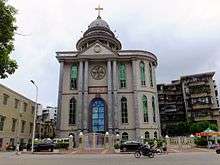
Most of the population in Shantou is non religious or practices traditional folk religions, Buddhism, Taoist rites, or worship of gods and ancestors. About 2% of the population belongs to an organised religion, with 40,000 Protestants, 20,000 Catholics and 500 Muslims.[22] St. Joseph's Cathedral of Shantou is the cathedral of the Roman Catholic Diocese of Shantou.
Infrastructure
Health
The public hospitals in the Shantou metropolitan area are operated by the Government of Shantou. Management of these hospitals and other specialist health facilities are coordinated by Shantou Board of Health.
Utilities
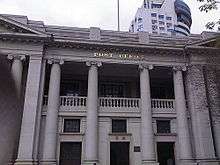
Shantou's electricity is provided entirely by China Southern Power Grid, postal service operated by China Post.
Telecommunications
Shantou is one of the most important international telecommunications ports in China. Four international submarine communications cables land at Shantou submarine cable landing station, including APCN 2, China-US Cable Network, SMW3 and South-East Asia Japan Cable System (SJC).[23]
China Telecom, China Unicom and China Mobile provide fixed lines, broadband internet access and mobile telecommunications services there.
Transport
Urban transport
The private car has matured as a transport option for Shantou residents. However, more still travel by autobikes. Public transportation is provided by bus, ferry and taxi.
Air
Shantou previously had its own civil airport, Shantou Waisha Airport. It was formerly the main airport serving the Shantou until nearby Jieyang Chaoshan Airport was opened on 15 December 2011. Shantou Waisha Airport became a military airbase since then and all civilian flights were transferred to the newly built airport in Jieyang.[24] Taxi is the usual way to travel between the airport and the city proper. The taxi fare is around 60 RMB.
Railways

There are 3 railway stations which serve Shantou: Chaoshan Railway Station and Chaoyang Railway Station which lie on the Xiamen-Shenzhen Railway line, and Shantou Railway Station which lies on the Guangzhou–Meizhou–Shantou Railway.
Tourism attractions

- Shipaotai Park (Chinese: 石炮台公园; pinyin: Shí pàotái gōngyuán)
- Chen Cihong's Former Residence (Chinese: 陈慈黉故居; pinyin: Chén Cíhóng gùjū)
- Nan'ao Island (南澳島 Nanao Dao): rated as Guangdong's most beautiful island by China's National Geographic magazine
- Palace-Temple of Old Mother (老媽宮 Laoma Gong): dedicated to the goddess Matsu
- Temple of Emperor Guan (關帝廟 Guandi Miao): dedicated to Guan Yu
- Tropic of Cancer Symbol Tower (北回归线标志塔 Beihuiguixian Biaozhita): The Tropic of Cancer slips through Centipede Mountain, which is 20 kilometers away from the city proper.
- Cultural Revolution Museum (文革博物馆 Wenge Bowuguan): The country's only museum dedicated to the Cultural Revolution.
- Shantou Museum (汕头博物馆 Shantou Bowuguan): An art museum.
- Shantou Founding Museum (汕头开埠博物馆 Shantou Kai Bubowuguan): This history museum is devoted to the establishment of Swatow (Shantou) as a treaty port in the 19th century, not to be confused with Shantou Museum.
Media
In 1912 Swatow had four newspapers, all in Chinese. They were Han Chao Pao, Ming Chuan (People's Rights), Ta Fung Pao (The Typhoon), and Ta Tung Pao (Eastern Times).[25]
Education
Education is overseen provincewide by the Guangdong Education Bureau.
Primary and secondary
Public primary and secondary schools provide education free.
A list of known schools:
- Shantou Jinshan Middle School
- Shantou Number One Middle School
- Shantou Experimental School
- Shantou Number four Middle School
- Shantou Number ten Middle School
- Shantou Number two Middle School
- Shantou Number three Middle School
- Dahua number one primary school
- Yuhuai Middle School
Colleges and universities
- Shantou University
- Guangdong Technion-Israel Institute of Technology (GTIIT)
- South China University of Technology Shantou College
- Shantou Polytechnic
- Shantou Radio and TV University
Sports
Twin towns — sister cities
Shantou is twinned with the following cities: [26]
| Country | City | County/District/Province/Region/State | Date |
|---|---|---|---|
| |
Kishiwada | Osaka Prefecture | June 2, 1990[27] |
| |
Saint John | New Brunswick | February 28, 1997[28] |
| |
Can Tho | N/A | August 1, 2005[29] |
| |
Johor Bahru | Johor | November 4, 2011[30] |
Friendly exchanges:
| Country | City | County/District/Province/Region/State | Date |
|---|---|---|---|
| |
Pyongtaek | Gyeonggi-do | March 25, 2003[31] |
| |
Fairfield | New South Wales | April 26, 2005[32] |
| |
Orlando | Florida | August 8, 2007[33] |
| |
Los Angeles | California | December 25, 2001[34] |
Prominent people
Many famous Chinese come from Shantou or their ancestral home is Shantou.
Entrepreneurs
- Mainland China
- Huang Guangyu (1969–), chairman of Gome Group and once the richest person in Mainland China
- Ma Huateng (1971–), Founder of Tencent Computer System Co., Ltd and creator of QQ
- Hong Kong
- Li Ka-shing (1928–; Chaozhou), tycoon
- Lim Por-yen (1914–2005), media tycoon, banker and charitarian
- Thailand
- Low Kiok Chiang (1843–1911), founder of Khiam Hoa Heng entreprises (1872-1950s)
- Singapore
- Tang Choon Keng (1901–2000), founder of Tangs
- Malaysia
- Teh Liang Teik (1923–2011), chairman of Malayan Flour Mills
Entertainment
- Hong Kong born
- Emil Chau (1960–) actor and singer
- Kwong Wah (1962–), actor and singer
- Canti Lau (1964–) actor and singer
- Sammi Cheng (1972–) actress and singer
- Mainland China
- Cai Chusheng (1906–1968), famous director, and the film "Yu Guang Qu" (渔光曲) directed by him received the first international film prize in China's history
Other
- Nuon Chea (1926–), politician
- Adele M. Fielde (1839–1916), missionary and author
- Qin Mu (1919–1992), writer
- Watchman Nee (1903–1972), theologian, and opponent of prosperity theology
- Tan Howe Liang (1933–), Singaporean weightlifting Olympian
- Xu Shilin (1998–), Chinese tennis player, Junior Olympic gold medallist
See also
References
- Miscellaneous series, Issues 7-11. United States Department of Commerce, Bureau of Foreign and Domestic Commerce, 1912.
Notes
- ↑ From postal romanization
- ↑ http://www.citypopulation.de/php/china-guangdong-admin.php
- ↑ 汕头1860的记忆
- ↑ Willis E. Hurd (August 1922). "North Pacific Ocean" (PDF). Monthly Weather Review. pp. 433–35. Retrieved 2007-07-05.
- 1 2 "Notes on weather in the other parts of the world" (PDF). Monthly Weather Review. p. 437. Retrieved 2007-06-14.
- 1 2 3 "The Selga Chronology Part II: 1901-1934". Universidad Complutense Madrid. Retrieved 2007-05-02.
- ↑ "NOAA's Top Global Weather, Water and Climate Events of the 20th Century" (PDF). NOAA. Archived (PDF) from the original on 28 June 2007. Retrieved 2007-06-28.
- ↑ 日军入侵 汕头沦陷
- ↑ 侵汕日军投降日 汕头人民欢天喜地庆祝胜利
- ↑ 中國汕頭政府-歷史沿革 (in Chinese). 汕头市政府门户网. Retrieved 2009-12-24.
- 1 2 中国地面国际交换站气候标准值月值数据集(1971-2000年) (in Chinese). China Meteorological Administration. Retrieved 2010-05-04.
- ↑ 北回归线标志塔
- ↑ McGinniss, Joe. Never Enough: A Shocking True Story of Greed, Jealousy and Murder. Simon & Schuster, December 25, 2012. ISBN 1471108384, 9781471108389. Google Books PT284.
- ↑ "中华人民共和国县以上行政区划代码". 中华人民共和国民政部.
- ↑ 汕头市国土资源局. 《汕头市土地利用总体规划(2006-2020年)》.
- ↑ 中华人民共和国国家统计局 (2012.12). 《中国2010年人口普查分县资料》. 中国统计出版社. ISBN 978-7-5037-6659-6. Check date values in:
|date=(help) - ↑ 中华人民共和国民政部 (2014.08). 《中国民政统计年鉴2014》. 中国统计出版社. ISBN 978-7-5037-7130-9. Check date values in:
|date=(help) - ↑ The Seattle Times (2006). E-waste dump of the world. Retrieved 9 March 2007
- ↑ RightSite.asia | Shantou Free Trade Zone
- ↑ 民航资源网(2002). 汕头——曼谷航班有了潮籍空姐. Retrieved 5 March 2007
- ↑ China Daily (2006). For all the tea in China, head to Shantou. Retrieved 26 July 2006
- ↑ 汕头宗教的主要特征
- ↑ "Shantou Submarine Cable Landing Station". Submarine Cable Networks website. Retrieved 24 February 2012.
- ↑ 揭阳潮汕机场今晨起飞首架航机. Netease (in Chinese). 2011-12-15. Retrieved 2013-01-23.
- ↑ United States Bureau of Foreign and Domestic Commerce, p. 187.
- ↑ "Sister Cities and Friendly exchange cities, the official website of the Shantou city". Retrieved 2009-10-30.
- ↑ "Sister Cities Kishiwada, the official website of the Shantou city". Retrieved 2009-10-30.
- ↑ "Sister Cities St.John's, the official website of the Shantou city". Retrieved 2009-10-30.
- ↑ "Sister Cities Can Tho, the official website of the Shantou city". Retrieved 2009-10-30.
- ↑ Liuxi (16 February 2012). "First Cultural Exchange after Shantou and Johor Bahru becomes Sister Cities". Shantou Daily. Shantou Government. Archived from the original on 30 June 2015. Retrieved 1 July 2015.
- ↑ "Sister Cities Pyongtaek, the official website of the Shantou city". Retrieved 2009-10-30.
- ↑ "Sister Cities Fairfield, the official website of the Shantou city". Retrieved 2009-10-30.
- ↑ "Sister Cities Orlando, the official website of the Shantou city". Retrieved 2009-10-30.
- ↑ "Sister Cities Los Angeles, the official website of the Shantou city". Retrieved 2009-10-30.
Further reading
- Herbert Allen Giles (1877). From Swatow to Canton: (overland). SHANGHAI : PRINTED AT THE "CELESTIAL EMPIRE" OFFICE: Trübner
LONDON : Trübner & CO. SHANGHAI : KELLY & WALSH. p. 74. Retrieved 10 February 2012. line feed character in |publisher= at position 9 (help)(Harvard University)
External links
| Wikimedia Commons has media related to Shantou. |
| Wikivoyage has a travel guide for Shantou. |
- (Chinese) Official government website
- Website of Shantou Government
- Shantou Daily
- Guangdong Statistical Yearbook
| Largest cities or towns in China Sixth National Population Census of the People's Republic of China (2010) | |||||||||
|---|---|---|---|---|---|---|---|---|---|
| Rank | Name | Province | Pop. | Rank | Name | Province | Pop. | ||
 Shanghai .jpg) Beijing |
1 | Shanghai | Shanghai | 20,217,700 | 11 | Foshan | Guangdong | 6,771,900 | 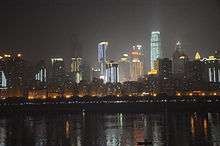 Chongqing 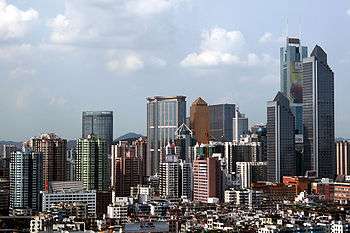 Guangzhou |
| 2 | Beijing | Beijing | 16,858,700 | 12 | Nanjing | Jiangsu | 6,238,200 | ||
| 3 | Chongqing | Chongqing | 12,389,500 | 13 | Shenyang | Liaoning | 5,890,700 | ||
| 4 | Guangzhou | Guangdong | 10,641,400 | 14 | Hangzhou | Zhejiang | 5,578,300 | ||
| 5 | Shenzhen | Guangdong | 10,358,400 | 15 | Xi'an | Shaanxi | 5,399,300 | ||
| 6 | Tianjin | Tianjin | 10,007,700 | 16 | Harbin | Heilongjiang | 5,178,000 | ||
| 7 | Wuhan | Hubei | 7,541,500 | 17 | Dalian | Liaoning | 4,222,400 | ||
| 8 | Dongguan | Guangdong | 7,271,300 | 18 | Suzhou | Jiangsu | 4,083,900 | ||
| 9 | Chengdu | Sichuan | 7,112,000 | 19 | Qingdao | Shandong | 3,990,900 | ||
| 10 | Hong Kong | Hong Kong | 7,055,071 | 20 | Zhengzhou | Henan | 3,677,000 | ||

